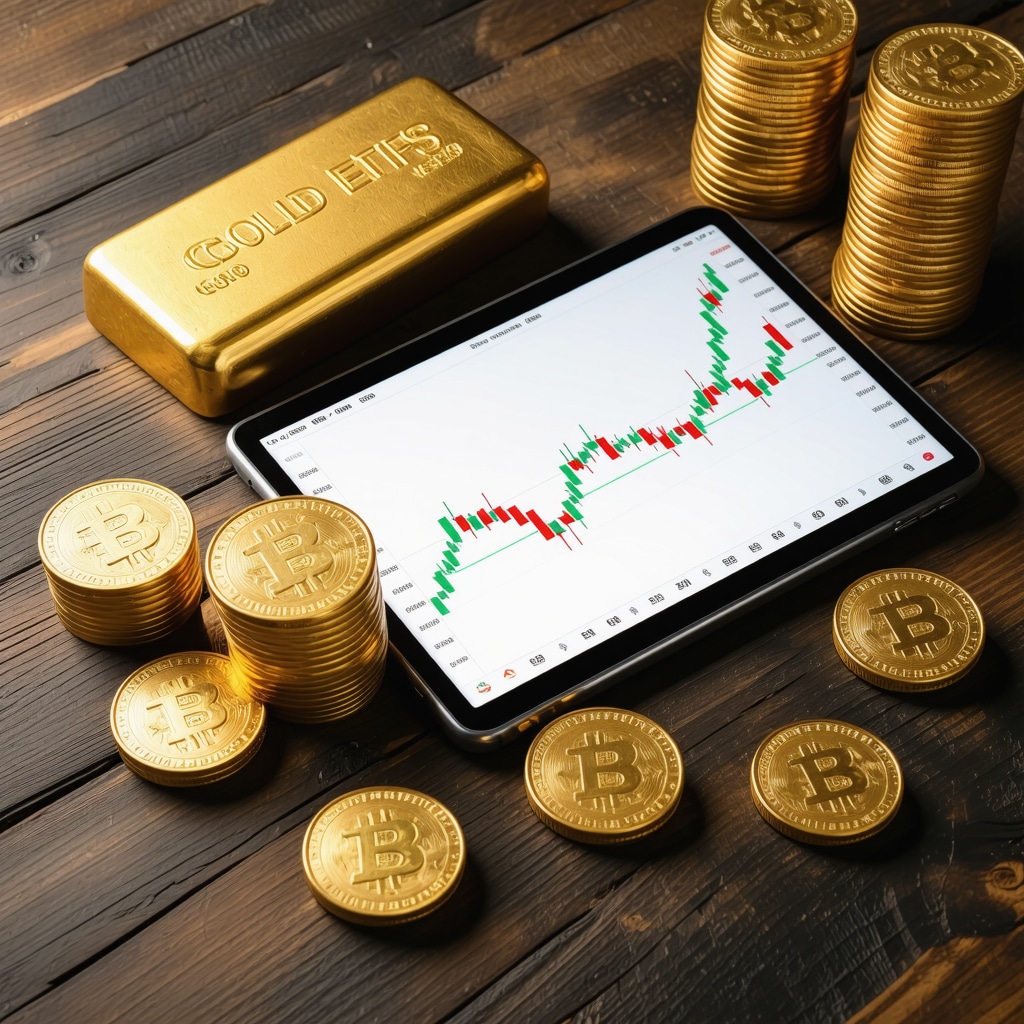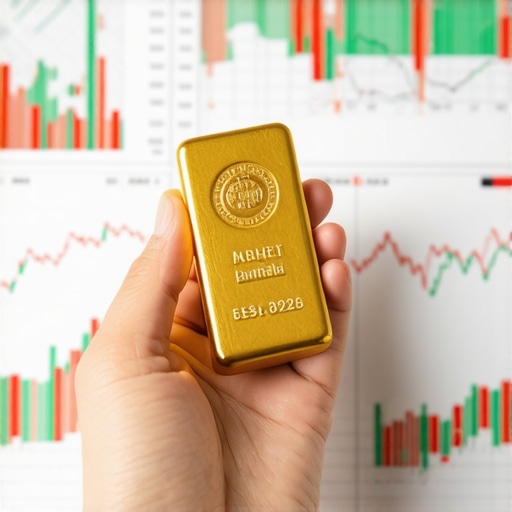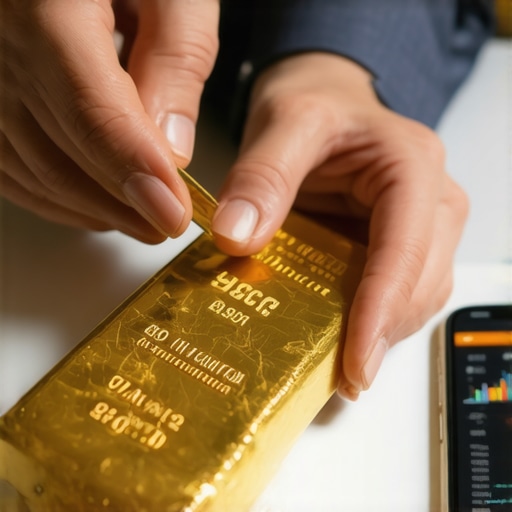Unlocking the Doors to Gold Investing: A Beginner’s Dilemma
For novice investors stepping into the glittering world of gold, the choice between physical gold and gold ETFs can seem daunting. Both investment avenues shine with potential, yet they cater to distinct investor needs, risk appetites, and logistical preferences. Understanding these nuances is critical to crafting a portfolio that balances security, liquidity, and growth potential effectively.
Beyond the Shine: The Tangible Allure of Physical Gold
Physical gold, encompassing coins, bars, and bullion, offers an almost primal appeal: ownership of an asset you can hold, store, and pass down. Its intrinsic value is historically proven as a hedge against inflation and currency fluctuations. For example, during periods of geopolitical uncertainty, investors often flock to physical gold, perceiving it as a sanctuary asset immune to digital market volatilities.
However, practical considerations such as secure storage, insurance, and potential liquidity constraints introduce complexities. Beginners must navigate the fine line between the security of tangible assets and the operational costs they entail. This tangible form also allows customization, as investors can choose from a variety of coins and bars with differing purity and premiums, tailoring their holdings to personal preferences and budgets.
Gold ETFs: The Digital Gateway to Gold Exposure
Gold Exchange-Traded Funds (ETFs) represent a modern, flexible alternative, allowing investors to gain exposure to gold prices without the need for physical possession. ETFs trade like stocks, offering liquidity and ease of transaction through brokerage accounts. This accessibility is appealing for beginners wary of the complexities tied to physical storage and authentication.
Moreover, ETFs typically have lower entry costs and eliminate the need for safe storage or insurance. However, investors must be aware of management fees and the potential counterparty risks inherent in financial instruments. Unlike physical gold, ETFs do not provide direct ownership of the metal but a claim on it, which introduces a layer of abstraction and market dependency.
How Do Risk Profiles Differ Between Physical Gold and Gold ETFs for Beginners?
Risk assessment is pivotal for beginners. Physical gold’s risks primarily revolve around security and liquidity, whereas gold ETFs face market and operational risks, including fund management and regulatory changes. For instance, in volatile markets, ETFs can be subject to price swings influenced by broader financial factors, while physical gold’s price is tethered more directly to supply-demand fundamentals.
Therefore, beginners must align their risk tolerance with the investment vehicle: those prioritizing control and long-term security may lean towards physical gold, while those valuing liquidity and ease of access might favor gold ETFs.
Expert Insights: Crafting a Balanced Gold Investment Approach
Experienced investors often advocate a hybrid strategy, combining physical gold’s stability with the flexibility of gold ETFs. This approach leverages the strengths of both, mitigating risks and enhancing portfolio diversification. For beginners, initiating investments with smaller allocations to both can build familiarity and confidence.
For a deeper dive into gold investment options tailored for newcomers, consider exploring our detailed guide on building a strong gold portfolio for beginners.
To further understand the dynamics shaping gold prices and investment timing, the World Gold Council provides authoritative insights, including how central bank purchases influence market trends, accessible at World Gold Council – Gold Demand Trends.
Curious about which gold investment aligns with your financial goals? Share your thoughts or questions below and join the conversation to learn from a community of passionate investors.
Personal Reflections on Balancing Physical Gold and ETFs
Reflecting on my journey with gold investments, I recall the initial hesitation I faced when deciding between holding tangible gold coins and diving into gold ETFs. The tactile satisfaction of owning physical gold is unmatched — there’s something reassuring about holding a gleaming coin or bar, knowing it’s a universal symbol of value. Yet, the convenience and liquidity of ETFs quickly became apparent, especially when life’s unpredictabilities made quick access to assets essential.
One experience that stands out was during a period of sudden market volatility. While my physical gold remained steadfast, the ETFs exhibited sharp price fluctuations. This contrast underscored for me the complementary roles both forms play in a diversified portfolio.
Understanding Practical Considerations: Storage and Costs
Owning physical gold brings with it responsibilities like secure storage and insurance. I personally explored various options, from home safes to bank safety deposit boxes. Each had trade-offs — home safes offer immediate access but require robust security measures, while bank boxes provide security but limit accessibility and sometimes incur fees.
Additionally, the premiums paid over spot prices for physical gold, especially for coins with numismatic value, can vary significantly. This is an important factor beginners often overlook. In contrast, gold ETFs generally have lower expense ratios but include annual management fees that subtly chip away at returns over time.
Have You Considered How Your Investment Horizon Affects Your Gold Choice?
This question was a turning point for me. Realizing that my investment timeline influences the suitability of physical gold versus ETFs helped clarify my approach. For short-term speculative plays or quick portfolio adjustments, ETFs are more practical. For long-term wealth preservation, physical gold offers a timeless hedge.
Learning from Trusted Sources: The World Gold Council’s Perspective
Delving into resources like the World Gold Council’s reports provided me with a broader understanding of gold demand trends, central bank activities, and market dynamics. Their data-backed insights enriched my perspective on how geopolitical events and economic policies impact gold prices globally.
For anyone serious about gold investment, these insights are invaluable for making informed decisions and anticipating market movements.
Exploring More on Gold Investment Strategies
If you’re intrigued by the prospect of blending physical gold and ETFs or want to deepen your knowledge on effective gold trading techniques, check out our comprehensive resources like best gold trading techniques to navigate the 2027 market and investing in gold ETFs and mutual funds. These guides offer practical advice tailored for both new and seasoned investors.
What’s your take on gold investing? Do you prefer the tangible security of physical gold, the liquidity of ETFs, or a mix? Share your experiences or questions in the comments below — let’s build a community where we learn and grow together.
Strategic Portfolio Integration: Leveraging Physical Gold and ETFs for Market Resilience
In the evolving landscape of global finance, a sophisticated approach to gold investment transcends mere allocation; it involves dynamic portfolio integration that harmonizes the tangible security of physical gold with the agile liquidity of gold ETFs. This synergy not only cushions portfolios against systemic shocks but also exploits market inefficiencies for enhanced returns.
Seasoned investors recognize that timing and market conditions dictate the weightage of each gold form within their holdings. For instance, during phases of heightened geopolitical tension or inflationary spikes, increasing physical gold allocations can safeguard wealth against currency devaluation. Conversely, in stable or bullish equity markets, gold ETFs offer nimble exposure to capitalize on price appreciation without the encumbrances of physical custody.
What Are the Advanced Risk Mitigation Techniques When Combining Physical Gold and Gold ETFs?
Combining physical gold and ETFs introduces a layered risk management framework, addressing liquidity risk, counterparty risk, and market volatility. A key technique involves staggering entry points for ETF purchases to mitigate timing risk, complemented by periodic audits of physical holdings to ensure authenticity and condition. Moreover, diversifying storage solutions—such as using insured vaults alongside private safes—reduces concentration risk.
Investors also deploy derivative instruments like gold options to hedge ETF positions, effectively capping downside while preserving upside potential. This multi-dimensional strategy demands not only thorough market analysis but also an adept understanding of financial instruments.
Decoding the Impact of Macroeconomic Indicators on Gold Investment Choices
Gold’s price trajectory is intricately linked to macroeconomic variables such as real interest rates, inflation expectations, and central bank policies. For example, persistent negative real yields historically bolster gold demand as an inflation hedge, favoring increased physical gold acquisition. Conversely, rising real yields can dampen gold’s allure, prompting tactical shifts towards ETFs that offer greater flexibility for rapid repositioning.
Understanding these correlations empowers investors to anticipate market movements and align their gold holdings accordingly. Central bank gold buying trends, detailed comprehensively by the World Gold Council, serve as a bellwether for institutional confidence and can inform individual strategies.
How Does Portfolio Duration Influence the Choice Between Physical Gold and Gold ETFs?
Portfolio duration—the investor’s intended holding period—critically shapes the gold investment vehicle choice. Long-term investors benefit from physical gold’s durability and intrinsic value preservation, effectively shielding wealth from protracted inflationary cycles. Meanwhile, short-to-medium-term investors may prefer gold ETFs for their superior liquidity and cost efficiency, facilitating quick rebalancing in response to market volatility.
In practice, a layered duration strategy can be employed: anchoring the portfolio with physical gold for foundational security while allocating a tactical portion to ETFs to capture short-term opportunities.
Integrating Technological Innovations: Digital Gold and Blockchain-Backed Assets
Emerging technologies are redefining gold investment paradigms. Digital gold platforms, leveraging blockchain technology, offer fractional ownership of physical gold stored in secured vaults, combining the best attributes of physical gold and ETFs. These innovations enhance transparency, reduce counterparty risk, and democratize access to gold investments for smaller investors.
Such platforms often incorporate smart contracts to automate transactions and ownership verification, presenting a compelling proposition for tech-savvy investors seeking both security and convenience. However, regulatory frameworks are still evolving, necessitating careful due diligence.
For those eager to explore these frontier investment vehicles, staying informed through trusted sources and expert analyses is paramount.
Considering the nuanced interplay of factors influencing gold investment decisions? Engage with our expert community by sharing your questions or insights below—let’s deepen our collective understanding and refine our strategies together.
Nuanced Portfolio Calibration: Harmonizing Gold Assets for Optimal Resilience
Elevating gold investment beyond conventional wisdom requires a sophisticated calibration of asset types and timing. Investors attuned to market cyclicality often adjust their physical gold and ETF allocations dynamically, responding to macroeconomic signals and geopolitical developments. This tactical agility is essential for mitigating systemic risks while capitalizing on transient market inefficiencies.
Moreover, layering investment horizons within gold portfolios enhances both security and growth potential. Long-term allocations to physical gold serve as a robust inflation hedge and store of value, whereas strategically timed ETF positions enable nimble responses to price momentum and liquidity demands.
What Metrics and Analytical Tools Can Expert Investors Use to Optimize Gold Portfolio Allocations?
Advanced investors leverage a suite of quantitative and qualitative tools to refine gold portfolio composition. Metrics such as the Gold-to-Real Interest Rate Spread, volatility clustering analysis, and macroeconomic scenario modeling inform allocation decisions. Technical indicators—including moving averages and relative strength indices—complement fundamental insights derived from central bank activity, inflation forecasts, and currency movements.
Additionally, integrating risk analytics platforms that simulate portfolio stress under varying economic conditions ensures preparedness against adverse scenarios. Utilizing these sophisticated tools requires both domain expertise and access to reliable data streams, underscoring the value of professional advisory and subscription-based research services.
Decoding Regulatory and Custodial Complexities in Gold Investment Vehicles
Investors navigating gold ETFs and emerging digital gold platforms must also contend with regulatory landscapes and custodial arrangements that significantly influence risk profiles. Custodianship of physical gold underlying ETFs demands rigorous audit protocols to guarantee asset backing, while digital gold offerings hinge on blockchain transparency and smart contract enforceability.
Regulatory scrutiny around anti-money laundering (AML), know your customer (KYC) compliance, and securities legislation varies by jurisdiction, affecting liquidity and investor protections. Staying abreast of these evolving frameworks is crucial for maintaining compliance and safeguarding investments.
Technological Frontiers: Blockchain-Enabled Gold Ownership and Smart Contract Automation
Blockchain technology is revolutionizing gold investment by enabling tokenized gold assets that represent fractional ownership with immutable provenance. These innovations facilitate instantaneous settlement, fractionalization, and enhanced transparency, reducing counterparty risk and operational frictions intrinsic to traditional gold custody.
Smart contracts automate dividend distributions, ownership transfers, and compliance checks, creating a trust-minimized environment. However, investors must exercise due diligence concerning platform security, regulatory acceptance, and interoperability with existing financial systems.
Integration of these technologies heralds a paradigm shift, blending the tangible merits of physical gold with the agility and accessibility of digital finance.
How Can Investors Effectively Evaluate Digital Gold Platforms for Security and Regulatory Compliance?
Evaluating digital gold platforms demands a multi-dimensional approach encompassing technological robustness, regulatory licensing, and transparency standards. Key considerations include the platform’s use of multisignature wallets, third-party custodial audits, and adherence to jurisdictional AML/KYC mandates. Independent security audits and whitepapers detailing blockchain architecture provide insights into systemic vulnerabilities and trustworthiness.
Consulting authoritative sources such as the World Gold Council and specialized fintech regulatory bodies aids in discerning credible platforms from nascent or unregulated entrants.
Empowering Your Gold Investment Journey: Engage with Expert Communities and Resources
Harnessing the full spectrum of gold investment opportunities demands continuous learning and interaction with expert communities. Engaging in forums, subscribing to professional newsletters, and attending webinars by reputable organizations like the World Gold Council enhance strategic acumen.
We invite you to explore these advanced insights, share your experiences, and pose complex questions to our knowledgeable network. Together, we can navigate the intricate landscape of gold investing with confidence and foresight.
Ready to refine your gold investment strategy with cutting-edge knowledge? Join the conversation and access exclusive expert analyses today!

Frequently Asked Questions (FAQ)
What are the main differences between physical gold and gold ETFs?
Physical gold involves owning tangible assets like coins and bars, offering direct control and long-term security but requiring secure storage and insurance. Gold ETFs represent shares in funds backed by gold, providing liquidity, ease of trading, and lower entry costs but introducing counterparty risk and management fees without physical possession.
How should beginners decide between investing in physical gold or gold ETFs?
Beginners should assess their investment horizon, risk tolerance, and preferences for liquidity versus tangibility. Those seeking long-term wealth preservation and control might prefer physical gold, while investors valuing convenience and flexibility may lean toward ETFs. A hybrid approach can also diversify benefits and risks.
What risks are unique to physical gold investments?
Physical gold carries risks related to theft, storage costs, insurance, and liquidity constraints. Premiums over spot prices and potential difficulties in selling during market stress are additional concerns. Authenticity verification and secure custody are critical to mitigating these risks.
What risks do gold ETFs present that physical gold does not?
Gold ETFs face market risk, management fees, counterparty and operational risks, and regulatory changes impacting fund operations. Unlike physical gold, they represent claims on gold rather than ownership, making them sensitive to financial market dynamics beyond gold price movements.
How do macroeconomic factors influence the choice between physical gold and ETFs?
Rising inflation and negative real interest rates often increase demand for physical gold as a durable hedge. Conversely, rising real yields and stable economic conditions may favor ETFs due to their liquidity and flexibility for tactical trading. Central bank gold purchases also signal trends that can guide allocation decisions.
Can digital gold platforms replace traditional physical gold or ETFs?
Digital gold platforms offer fractional ownership of physical gold stored securely, combining benefits of tangibility and liquidity through blockchain technology. While promising enhanced transparency and accessibility, they require careful evaluation of regulatory compliance, security protocols, and platform credibility before adoption.
What advanced strategies can optimize combining physical gold and gold ETFs?
Experts employ dynamic allocation adjusting to economic cycles, diversify storage, stagger ETF purchases, and use derivatives like options to hedge positions. They also leverage quantitative metrics and scenario modeling to balance risk, liquidity, and returns effectively within a multi-horizon portfolio.
How does investment duration impact gold vehicle selection?
Long-term investors typically favor physical gold for its enduring value and inflation protection, while short-to-medium-term investors benefit from ETFs’ liquidity and cost efficiency. A layered approach can anchor portfolios with physical gold and tactically utilize ETFs for active market participation.
What regulatory and custodial factors should investors consider?
Regulations around AML/KYC, securities laws, and audit requirements vary by jurisdiction and investment vehicle. Physical gold custody demands secure, insured storage with verified provenance; ETFs require transparency and compliance from fund managers; digital gold relies on blockchain integrity and smart contract enforceability.
How can investors assess the security of digital gold platforms?
Evaluating digital gold platforms involves scrutinizing technological safeguards such as multisignature wallets, third-party audits, regulatory licenses, transparency reports, and compliance with AML/KYC laws. Consulting trusted organizations like the World Gold Council and fintech regulatory bodies aids in identifying credible providers.
Trusted External Sources
- World Gold Council (https://www.gold.org): A leading authority on gold market research, offering comprehensive data on gold demand trends, central bank activities, and investment insights critical for informed decision-making.
- London Bullion Market Association (LBMA): Provides standards and regulatory frameworks for physical gold trading and custody, essential for understanding market integrity and compliance.
- International Monetary Fund (IMF): Offers macroeconomic analyses and reports on global financial stability, helping investors grasp how economic indicators impact gold prices and investment strategies.
- Financial Conduct Authority (FCA) and Securities and Exchange Commission (SEC): Regulatory bodies that oversee ETFs and digital asset frameworks, providing guidelines crucial for evaluating investment vehicles’ legal and operational risks.
- Academic Journals on Financial Economics: Peer-reviewed research papers analyzing gold’s role in portfolio diversification, risk mitigation, and behavioral finance, enriching expert-level understanding.
Conclusion: Mastering Gold Investment Through Informed Strategies
Gold investment transcends a simple choice between physical assets and financial instruments; it demands a nuanced understanding of risk profiles, market dynamics, and investor objectives. Physical gold offers enduring security and inflation protection, while gold ETFs provide liquidity and trading convenience. Emerging digital gold innovations blend these advantages, expanding access and transparency.
Integrating these options thoughtfully, aligned with macroeconomic insights and personal investment horizons, enables resilient and adaptive portfolio construction. Advanced analytical tools and regulatory awareness further empower investors to optimize allocations and mitigate risks.
Embrace the multifaceted nature of gold investing by engaging with expert communities and trusted resources. Share your experiences, ask questions, and apply these insights to craft a gold strategy that shines with confidence and foresight.
Ready to elevate your gold investment journey? Join the discussion, explore our expert guides, and transform knowledge into strategic advantage today.
#IMAGE_PLACEHOLDER_D#










